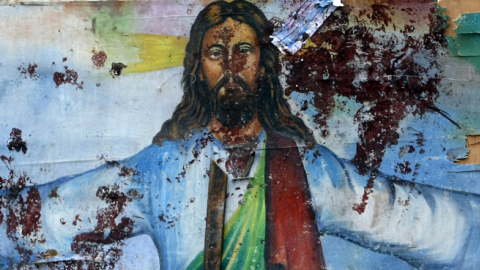The attack began at 2:45 a.m. on July 5th 2013. Fifteen minutes earlier, the body of a Muslim resident of Naga’a Hassan was found on the banks of the Nile. Though it remains unclear until today who had killed him, the angry mob that had gathered had one target in mind, the 275 families that make the Christian population of the village. For the next eighteen hours a three-hundred-strong mob roamed the village streets moving from house to house, searching for any Christian they could find, searching to kill.
Early victims suffered from knife wounds and were beaten with metal sticks. Frightened Christians began calling the police and local authorities from the early morning. Help, however, never arrived. The local police were reinforced during the day with more troops from Luxor, but did nothing to prevent the pogrom. 110 houses were attacked that day. Some of them were burned, many of them were looted.
The pogrom culminated with the attack on the Habib house by 7 p.m., sixteen hours after the first attacks. Three brothers with their families lived in that house and were joined by two neighboring families who hoped the iron gated house would offer them protection. Thirteen women, seven men and numerous children were trapped inside. As the mob surrounded the house, the armed officers on the scene reached a deal with them; the women and children would be taken away, the men left for the mob. The women begged the officers to save their husbands. Nobeya Zaki, a mother of two men later stated: “I kissed the police officer’s hands and legs and begged him to protect my two sons and take them out; I told him: ‘their father died after they were born and I raised them – please take them out.”
Their cries were met with police indifference. The women, who wore two layers of cloths, took off their outer cloths and tried to cover their men in them, the police refused, they had given their word to the mob. Only one man managed to leave with the women as he tightly held his two twin daughters in his arms. Six men were left inside. Only two survived what happened next.
The officers were still holding the door when the mob pushed through. At least one of the officers never left. One survivor later recalled hearing him tell the mob during the murders to get done and finish it up. It took the mob half an hour to complete the job. The bodies of the four murdered Christians were filled with knife wounds and marks of beatings by metal sticks. Asked later, Major Khaled Mamdouh, the officer in charge of Naga Hassan found nothing to fault in his troops’ behavior. He told Human Rights Watch: “There was no reason for the police to take any special measures, it’s not [the police’s] job to stop killings, we just investigate afterward.” He denied that the attack was sectarian in nature adding that “You’ll see, come back in a month and everyone will be telling you that nothing ever happened here.” One of the victims’ wives later said: “Why did they [the police] let this happen? Why didn’t they take the men? They could have saved all of us. They sacrificed the men… Is it our fault that we were born Christian?”
The brutal murder of Christians in Egypt’s Naga’a Hassan is hardly the worst in the ongoing rising wave of persecution faced by Christians around the world. In his well researched new book, “The Global War on Christians,” John Allen takes us on a forceful tour, documenting the brutal reality of what it means to be Christian in many countries. The global onslaught is ecumenical in nature, no Christian sect or denomination is spared. While some of the stories have made it into the mainstream media, Allen’s more complete accounting is shocking to his readers. Not claiming to be a complete listing of all the stories of persecution around the globe, the book nevertheless introduces its readers to martyrs and Christian victims in forty-seven countries. It will be hard for readers to forget the names and tragic stories of Umar Mulinde, Youcef Nadarkhani, Dritian Prroj, Fausto Tentorio, and the Burundi Seminarians.
Allen divides his account into three parts, a long geographical overview of the war on Christians, a shorter deconstruction of the myths associated with the global war, and a tight analysis of the war’s consequences and what can be done about it. With the exception of the last chapter devoted to what could be done, the division matters little. The stories of persecution are intertwined with Allen’s attempt to counter the myths and examine their impact throughout the book.
Allen’s broad definition of persecution has received criticism from many reviewers. He is correct to conclude that “In assessing the scope and scale of today’s war on Christians, it’s not enough to consider what was in the mind of the person pulling the trigger-we also have to ponder what was in the heart of the believer getting shot,” And that we must ponder what the religious motives that drove the victims to place themselves in danger. But some of the stories he tells don’t involve clear elements of religious persecution. Including them opens the otherwise gripping narrative to unnecessary criticism. He makes a strong argument for including many stories where the motive of the murderer may not have been religious such as Burundi and Colombia, but is less convincing with others in Chile and Cameroon. The overall number of Christian deaths in the global war is cited at one hundred thousand, with Congo contributing the most through its civil war. Without a more thorough examination of that conflict, debates about the number threaten to create an unnecessary sideshow to an otherwise important book.
Aware of contentious discussions of religious freedom in the polarized American political debate, Allen hopes his book can contribute to holding together coalitions such as that between Republican Congressman Frank Wolf and Democrat Anna Eshoo on behalf of Middle East Christians. He thus shies away from controversial issues that may alienate the liberal base. He takes great care in countering their skepticism and branding the issue in terms accessible to them. He differentiates between the actual war underway in much of the globe as he describes it and the metaphorical war on religion in the United States. His efforts are laudable and necessary, yet political correctness leads to problematic statements. For example, he suggests a moral equivalency between the Islamist threat to Christians and Israeli security policies, takes a few unnecessary swipes at the George W. Bush administration, and describes Hezbollah as a group “seen in the West as a terrorist organization.”
The weakest aspect of the book is Allen’s attempt at dealing with the question of Islamism. While it is true that “It would be a mistake to conclude that Islam and its discontents are the lone force in the global war on Christians,” there is no denying that Islamists continue to be the main aggressors against Christians. Of the twenty-five countries that Open Doors list as the most hazardous to Christians, eighteen are Muslim-majority countries. Even in countries that are not Muslim-majority such as Russia and Kenya, Islamism significantly contributed to the threats that Christians face. Of the 126 pages in the book devoted to telling the stories of persecution, a full sixty-two pages are set in countries where the war on Christians is being conducted by Islamists. Allen contends that Hindu radicalism will come to be regarded as a primary threat to global stability in the same way that Islamic radicalism is today. I find such a claim extremely implausible.
The uniqueness of the Islamist threat to Christians is amplified by its success. Unlike other regions in the world, where Christianity is experiencing a flourishing revival and in many countries in Asia and Africa winning converts by the millions, the Middle East and the larger Islamic world is the one region where Christianity is facing the threat of extinction. The Middle East is unique not only as the birthplace of Christianity and home to ancient churches that shaped what it means to be Christian, but more importantly because Christianity is being eradicated from it.
Allen rightly notes that “most people in the West have little idea” of the threats Christians endure around the world. He identifies the biases that blind many secular people to the staggering plight include a general hostility towards organized religion, the view of Christianity as Western and as an agent of oppression, and political correctness, or as Regis Derby put it: The victims are too Christian to excite the left, too foreign to interest the right. This was not always the case. In the mid 90’s a grand coalition came together to press for religious freedom. It successfully forced a reluctant Bill Clinton to sign the International Religious Freedom Act of 1998. Many of the heroes of that struggle have since passed away and were not replaced with equally enthusiastic fighters.
More profoundly, the failure to act is the failure of Western churches. If the silence of the seculars can be explained, how can one comprehend that of Western Christians? Allen offers some explanations: Christians in the United States have no personal experience of persecution, they are too American-centric, their churches too attached to a kind of political correctness when it comes to discussing other faiths, and too divided among themselves to offer a collective response.
Yet Allen is hopeful. The “defense of persecuted Christians will increasingly become a front-burner priority for the various churches,” he says. Persecution however horrific will bear great spiritual fruits creating an ecumenism of the martyrs. The church will grow more diverse, what he terms “theology” from below will grow, and the blood of the martyrs will foster a renewed spirit for evangelization.
All of these wonderful things may come to pass, but for them to happen the existing wall of separation between American Christianity and the rest of the world must come down. The story of the immigrant churches themselves provides a cautionary tale. Second generation Copts in the United States feel little attachment to the plight of their brethren in Egypt. The melting pot has done its wonders. They may have kept the faith of their fathers, but it remains to be seen for how long and the cultural affinity has fast eroded. The persecuted Christian’s dilemma is simple, without the United States actively engaged for religious freedom, little will change. But how can they possibly get the US engaged if its very Christians seem not to care?
(This article's original publication date is August 1, 2014.)



















